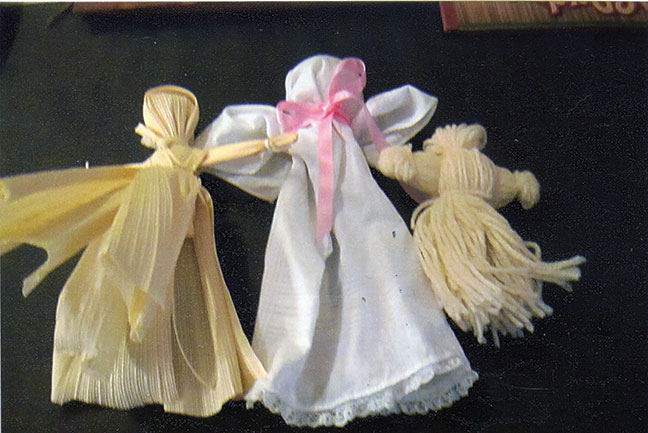Some of the earliest toys in colonial New England, including Rochester, were dolls. The three dolls shown in the picture would have been home made using readily available material. The yarn doll on the right could be put together quickly with leftover yarn. This would not be one of the earliest dolls as it first required sheep or some other source of wool and a spinning wheel.
The doll on the left is made of corn husks. These dolls were first seen by settlers in the hands of young girls who were part of the few remaining clusters of Native Americans, still in the lands that the proprietors purchased in 1679. These dolls are fashioned out of actual corn husks that have been soaked in water to make them easier to work with.
Cathy Phinney, one of our living history reenactors, at the Historic Fair in June, made this doll and others in the manner of a colonial housewife.
The middle doll answers a question from an earlier article. That article had an accompanying picture of a house decorated for Halloween. Among the decorations were cloth ghosts. The doll in our exhibit is not a ghost, but a “church doll”. The making of both the ghosts and the church dolls is similar, though the dolls often had more detail.
Colonial Sabbath services were all-day affairs with a break in the middle of the day for a chance to eat and do a bit of socializing. There were no special Sunday schools for children who were expected to sit quietly through the long hours. Some mothers made small dolls out of a triangle of cloth (the size of a handkerchief) to provide a quiet diversion, hence the name “church doll”.
If you haven’t yet had a chance to visit our new exhibit, I hope you watch for an opportunity to do so. You can always get in touch with us (sash48@ comcast.net or eshbach2@aol.com) to schedule a visit for yourself or a group. I want to belatedly thank the Rochester Scouts and the Wareham Minutemen Militia for their part in making our Historic Fair with a Colonial Flair a success.
By Connie Eshbach
